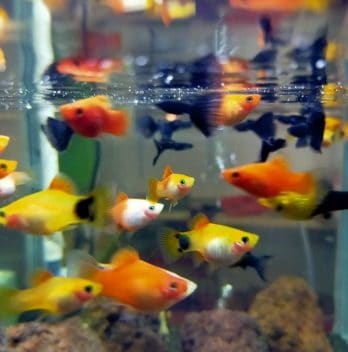Now, you might be wondering what the standard aquaponic fish to plant ratio is, we will let you know in this post.
Aquaponics is an awesome approach to combining fish with plants to yield great results. Aquaponics fish to plant ratio is important to consider if you wish to maximize the end product in your aquaponics system. So let’s discuss what it is.
Brief Into Aquaponics
The fish in your aquaponics excretes their waste product as ammonia which is the fertilizer generator. This ammonia is transformed into nitrate by the beneficial bacteria for the use of your plants. The plant in turn purifies these wastes from the fish tank by absorbing them.
So, the number of fish you are raising should produce adequate fish waste for your plants’ use. Also, the fish food used in feeding the fish should be enough to produce optimal nutrients for plant use.
If this fish waste is not enough, your plants might be deficient in nutrients and might not grow well. This is why we need to get the aquaponics fish to plant ratio for a better yield.

Talking About The Fish To Plant Ratio In Aquaponic
When we talk about fish to plant ratio in aquaponic, we will need to know the size of grow bed to know the plant ratio. That is, if you’re making use of a grow bed, the size of the grow bed will determine the capacity of the plant.
It is recommended that the volume of the fish tank should be approximately equal to the grow bed volume. This implies that the ratio of the aquaponics fish tank to plant should be approximately 1:1. However, if we’re looking at it from a commercial structure, we can raise the ratio to 1:3 or 1:4 based on the density of fish and the rate of water flow.
Let’s talk about the rate at which you feed your fish because it’s a direct factor to consider in the aquaponics ratio.
Feeding Rate Factor
You should note that the ratio of fish to plants also depends on how you feed your fish. This is because of the nutrient waste they will provide your plant. Normally, fish can make use of about 80% of food and expel 20% of nutrient waste materials.
In a standard situation, the recommended grow bed size should be at least 12 inches deep and let’s assume you have 5 feet by 5 feet grow bed. Then the appropriate food to feed your fish will be around 20 to 40 grams per day square meters.
Other Factors
Other factors to consider that can influence the capacity of fish to plant are the volume of the grow bed and the density of the growing media used. Note that the growing media encourages good bacteria colony. So, in a standard condition, we can recommend 1 kilo of fish per 50 liters of grow bed.
Another point to note is the ammonia and bacteria population. A good bacteria population quantity will enhance the conversion of ammonia to nitrate for the use of your plant. This implies if there’s a limit in the bacteria population, you will be limited to the number of fish you can have in your aquaponics system. This will limit you from getting enough fish production and reduce the nutrient that your plant is supposed to receive.
Quality of Water
Now, when it comes to the quality of water in aquaponics, you should understand why the fish to plant ratio is important as well as the bacteria population. For example, if the waste materials that serve as nutrients for the fish are not able to be absorbed by your plants, it can pollute the water quality.
If there’s too many fish in the water and there are not enough bacteria to convert ammonia to nitrates, the bio-filtering plants will not able to absorb and purify all these wastes. This turns into toxic ammonia in the fish water tank and ammonia can be pretty harmful to your fish.
Although a couple of plants may grow, however, the issue of polluted fish water is not solved. This can reduce the growth and activities of the fish. A possible approach to this situation is to introduce enough helpful; bacteria that can convert ammonia to absorbable nitrate for plant use.
It also helps if you can decrease the fish feed to reduce the fish waste products that are slowing the growth of your fish or simply reduce the biomass of your fish.
Final Say On Aquaponic Fish To Plant Ratio
An efficient and productive aquaponics system is the goal of every farmer. Thus, sustaining the nutrient balance from the supply of your fish to your plants is crucial. This is why getting the right aquaponic plant fish to plant ratio in aquaponics is important.

Eunice is an enthusiastic gardener with a passion for growing beautiful flowers. She loves nothing more than spending time in her garden, tending to her plants and enjoying the outdoors. Eunice has been gardening for over 15 years and has developed a unique style of landscaping that is both practical and aesthetically pleasing. She is especially fond of growing roses and enjoys experimenting with different varieties and colors. Eunice takes great pride in her garden and often shares the fruits of her labor with friends and family. In her spare time, she enjoys reading gardening magazines and attending local horticulture events. Eunice is passionate about her hobby and is always eager to share her knowledge and experience with others.





